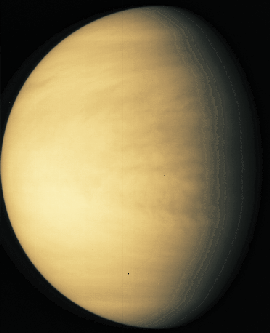
Venus: Earth's Sister Planet
Credit: NASA, Galileo
Discover the cosmos! Each day we feature a different image or photograph of our fascinating universe, along with a brief explanation written by a professional astronomer.
August 15, 1995

Venus: Earth's Sister Planet
Credit:
NASA,
Galileo
Explanation: This picture in visible light was taken by the Galileo spacecraft. Venus is very similar to Earth in size and mass - and so is sometimes referred to as Earth's sister planet - but Venus has a quite different climate. Venus' thick clouds and closeness to the Sun (only Mercury is closer) make it the hottest planet - much hotter than the Earth. Humans could not survive there, and no life of any sort has ever been found. When Venus is visible it is usually the brightest object in the sky after the Sun and the Moon. More than 20 spacecraft have visited Venus including Venera 9, which landed on the surface, and Magellan, which used radar to peer through the clouds and make a map of the surface. There are still many things about Venus's unusual atmosphere that astronomers don't understand.
Tomorrow's picture: Uranus: The Tilted Planet

We are proud to acknowledge that an external review by
Point Communications
has rated Astronomy Picture of the Day in the top 5 percent of all
World Wide Web sites.